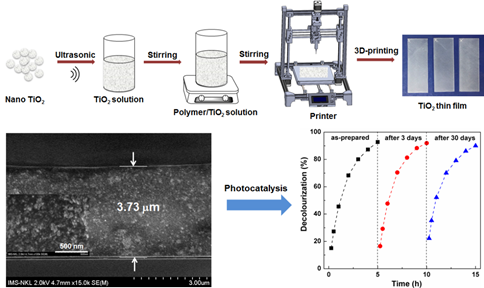CÁC THÀNH TỰU CHÍNH

Department Head
Assoc.Prof.Ung Thi Dieu Thuy
|
MAIN RESEARCH DIRECTION:
-
Synthesize (i) high luminescent quantum dots (QDs) of II-VI, III-V, I-III-VI2 compounds in types I and II core/shell structures; (ii) plasmonic nanostructures based on the noble metals (Au, Ag) for fluorescent labeling/biosensor applications; and (iii) photocatalytic nanomaterials based on the copper, titanium, transition metals compounds to aim for treating environmental pollution and converting energy
-
Study the influence of temperature and excitation power density on optical, optoelectronic properties of nanomaterials by using steady-state and time-resolved photoluminescence that allows investigating electron-hole transitions in the materials (NAFOSTED funding); photocatalytic materials focus on wastewater treatment and self-cleaning ability (NAFOSTED and VAST)
|
 dieuthuy@ims.vast.ac.vn dieuthuy@ims.vast.ac.vn |
 +84 967 068 416 +84 967 068 416 |
Our lab has been synthesizing and investigating optical/optoelectronic properties, as well as researching on the applicative prospects of optoelectronic nanomaterials/nanostructures.
We have successfully synthesized the QDs of II-VI (CdSe(Te), ZnS(Se)), III-V (InP, GaP) và I-III-VI2 (CuInS(Se)2, AgInS(Se)2) compounds with/without doped rare-earth element (Eu3+:In(Zn)P/ZnS), transition metal (Mn2+:ZnSe/ZnS). The quantum yield of these QDs can be reached up to 85% in the controlled spectral range from 400 to 800 nm. These QDs provides outstanding samples not only in fundamental research but also in practical applications such as biosensors for the fast detecting/analyzing of several pesticides, avian flu virus,…
Figure 1. (a) CdSe/ZnS QDs in n-hexane, (b) CdTe/CdS QDs in water, (c) InP/ZnS QDs in n-hexane, and (d) CuInS2/ZnS QDs in n-hexane. With the excellent quality and high luminescent quantum yield, photoluminescent colors of these QDs can be easily observed in roomlight.
Gradually perfecting the fabrication technology of nano-TiO2 brookite thin film coated on the glass surface by direct-ink-writing using 3D printer without further high-temperature treatment. Some polymer binders (PVA, PVP, DC-668) are used to obtain strong adhesion between the TiO2 layer and glass surface during the 3D-printing process. The photocatalytic experiments and and recyclability tests were carried out using the peristaltic pump system (275 ml/min) which helps to circulate and homogenize the dye rose bengal pollutant solution during reaction. The TiO2-DC668 thin film does not show a significant decrease in its photocatalytic performance after four repeated uses proving the high attachment of the thin film photocatalyst onto the glass substrate as supporting material. Also, the tested thin films did not appear peeling which confirms some of the advantages of DC668 polymer such as resistance against ultraviolet radiations, high durability, chemical inertness, and easy availability.
 Figure 2. Fabrication and photocatalytic activity of TiO2 brookite thin film.
Figure 2. Fabrication and photocatalytic activity of TiO2 brookite thin film.
-
T. T. T. Huong, N. T. Loan, D. X. Loc, U. T. D. Thuy, O. Stoilova and N. Q. Liem, Optical Materials 113 (2021) 110858. Enhanced luminescence in electrospun polymer hybrids containing Mn-doped ZnSe/ZnS nanocrystals.
-
Long V. Le, Young D. Kim, David E. Aspnes, Optics Express 28 (2020) 38917-38933. Quantitative assessment of linear noise-reduction filters for spectroscopy, (IF = 3.669)
-
Tran Thi Thuong Huyen, Tran Thi Kim Chi, Hendrik Kosslickb and Nguyen Quang Liem, Progress in Natural Science: Materials International 29 (2019) 641-647. Highly active brookite TiO2-assisted photocatalytic degradation of dyes under the simulated solar-UVA radiation. (IF = 4).
-
U. T. D. Thuy, N. T. Thuy, N. T. Tung, E. Janssens, and N. Q. Liem, APL Materials 7 (2019) 071102. Large-area cost-effective lithography-free infrared metasurface absorbers for molecular detection. (IF: 4.296).
-
Hoang V. Le, Ly T. Le, Phong D. Tran, Jong-San Chang, Ung Thi Dieu Thuy, Nguyen Quang Liem, International Journal of Hydrogen Energy 44 (2019) 14635-14641. Hybrid amorphous MoSx-graphene protected Cu2O photocathode for better performance in H2 evolution. (IF: 4.084).
-
Fu Feng, Loan Thu Nguyen, Michel Nasilowski, Brice Nadal, Benoît Dubertret, Laurent Coolen, Agnès Maître, “Consequence of shape elongation on emission asymmetry for colloidal CdSe/CdS nanoplatelets”, Nanoresearch 7 (2018) 3593–3602. (IF: 7.994).
-
U. T. D. Thuy, I. Borisova, O. Stoilova, I. Rashkov, N. Q. Liem, Catalysis Letters 148 (2018) 2756–2764. Electrospun CuS/ZnS–PAN Hybrids as Efficient Visible-Light Photocatalysts. (IF: 2.911).
-
T. T. T. Huyen, T. T. K. Chi, N. D. Dung, H. Kosslick and N. Q. Liem, Nanomaterials 8 (2018) 276. Enhanced Photocatalytic Activity of {110}-Faceted TiO2 Rutile Nanorods in the Photodegradation of Hazardous Pharmaceuticals. (IF: 3.504).
-
Ung Thi Dieu Thuy, Weon-Sik Chae, Won-Geun Yang, Nguyen Quang Liem, Optical Materials 66 (2017) 611-615. Enhanced fluorescence properties of type-I and type-II CdTe/CdS quantum dots using porous silver membrane. (IF: 2.238).
-
Huyen Thi Thuong Tran, Hendrik Kosslick, Muhammad Farooq Ibad, Christine Fischer, Ursula Bentrup, Thanh Huyen Vuong, Liem Quang Nguyen, Axel Schulz, Applied Catalysis B: Environmental 200 (2016) 647-658. Photocatalytic Performance of Highly Active Brookite in the Degradation of Hazardous Organic Compounds Compared to Anatase and Rutile. (IF: 8.328).
1. Several equipment for fabricating materials: hydrothermal synthesis reactors, microwave reactor, Auto Spray Pyrolysis,…
2. Một số thiết bị nghiên cứu tính chất quang của vật liệu: hệ đo huỳnh quang phân giải thời gian (streak camera có thể phân giải đến vùng chục ps) và phân giải phổ cao (hệ iHR550);
3. A high-resolution luminescence instrument allows measuring steady-state (iHR550) and time-resolved photoluminescence (streak camera, it is capable to capture signals in the order of a few picoseconds).
4. A few instruments are used to study photocatalytic properties of materials such as Gas Chromatograph (Clarus 690 PerkinElmer/USA) and potentiostats (Biologic-SP300, SP50).
5. An ellipsometer (Horiba UVISEL Plus) that allows investigating the dielectric properties (complex refractive index or dielectric function) and thickness of thin films in the spectral range from 190 to 2100 nm.
6. Dilatometer (Linseis/Germany) is used for the measurement of dimensional changes in material as a function of temperature from RT to 1400 oC. The instrument can measure the sample length change DL from 100 µm to 5000 µm and its resolution is 0,125nm/digit.